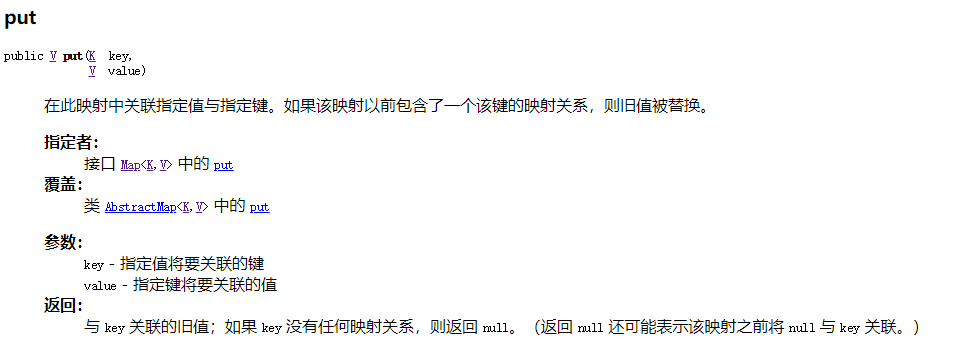API文档中的描述:

先看一个例子
Map<Character, Integer> map = new HashMap<Character, Integer>(); System.out.println(map.put('a', 0)); // null System.out.println(map.put('a', 1)); // 0 System.out.println(map.put('a', 2)); // 1 System.out.println(map.put('b', 1)); // null System.out.println(map.put('b', 2)); // 1 System.out.println(map.get('a')); //2
可以看出:put方法的返回值为null或value;
调用put方法时,如果已经存在一个相同的key, 则返回的是前一个key对应的value,同时该key的新value覆盖旧value;
如果是新的一个key,则返回的是null;
通过hashmap的源码可以看出:
map中一个映射不能包含重复的键。每个键最多只能映射一个值。即相同的key在Map中只会有一个与之关联的value存在。
put()方法实现:首先使用hash(key)得到key的hashcode(),hashmap根据获得的hashcode找到要插入的位置所在的链,在这个链里面放的都是hashcode相同的Entry键值对,
在找到这个链之后,会通过equals()方法判断是否已经存在要插入的键值对,而这个equals比较的就是key。
添加对应的key-value这样的键值对node时,如果原本已经存在相同的key,则直接改变对应的value,并返回旧的value;如果不存在相同的key,则插入,在插入链表时,如果链表长度为临界长度TREEIFY_THRESHOLD,再插入任何元素就要变成红黑树。
public V put(K key, V value) { return putVal(hash(key), key, value, false, true);//put方法调用putVal方法 } /** * Implements Map.put and related methods * * @param hash hash for key * @param key the key * @param value the value to put * @param onlyIfAbsent if true, don't change existing value * @param evict if false, the table is in creation mode. * @return previous value, or null if none */ final V putVal(int hash, K key, V value, boolean onlyIfAbsent, boolean evict) { Node<K,V>[] tab; Node<K,V> p; int n, i; if ((tab = table) == null || (n = tab.length) == 0) n = (tab = resize()).length; if ((p = tab[i = (n - 1) & hash]) == null) tab[i] = newNode(hash, key, value, null); else { Node<K,V> e; K k; if (p.hash == hash && ((k = p.key) == key || (key != null && key.equals(k)))) e = p; else if (p instanceof TreeNode) e = ((TreeNode<K,V>)p).putTreeVal(this, tab, hash, key, value); else { for (int binCount = 0; ; ++binCount) { if ((e = p.next) == null) { p.next = newNode(hash, key, value, null); if (binCount >= TREEIFY_THRESHOLD - 1) // -1 for 1st treeifyBin(tab, hash); break; } if (e.hash == hash && ((k = e.key) == key || (key != null && key.equals(k)))) break; p = e; } } if (e != null) { // existing mapping for key //key已经存在 V oldValue = e.value; //将已经存在的结点e的value值赋给oldValue if (!onlyIfAbsent || oldValue == null)//当onlyIfAbsent为false或者oldValue为null时,进行覆盖操作 e.value = value;//覆盖原结点的value值,用新值替换旧值 afterNodeAccess(e); return oldValue;//返回的是被覆盖的oldValue } } ++modCount; if (++size > threshold) resize(); afterNodeInsertion(evict); return null; }
在hashset中的add方法调用的就是hashmap的put方法,判断put方法的返回值是否等于空,来保证hashset的值不重复。
private transient HashMap<E,Object> map; /** * Adds the specified element to this set if it is not already present. * More formally, adds the specified element <tt>e</tt> to this set if * this set contains no element <tt>e2</tt> such that * <tt>(e==null ? e2==null : e.equals(e2))</tt>. * If this set already contains the element, the call leaves the set * unchanged and returns <tt>false</tt>. * * @param e element to be added to this set * @return <tt>true</tt> if this set did not already contain the specified * element */ public boolean add(E e) { return map.put(e, PRESENT)==null; }